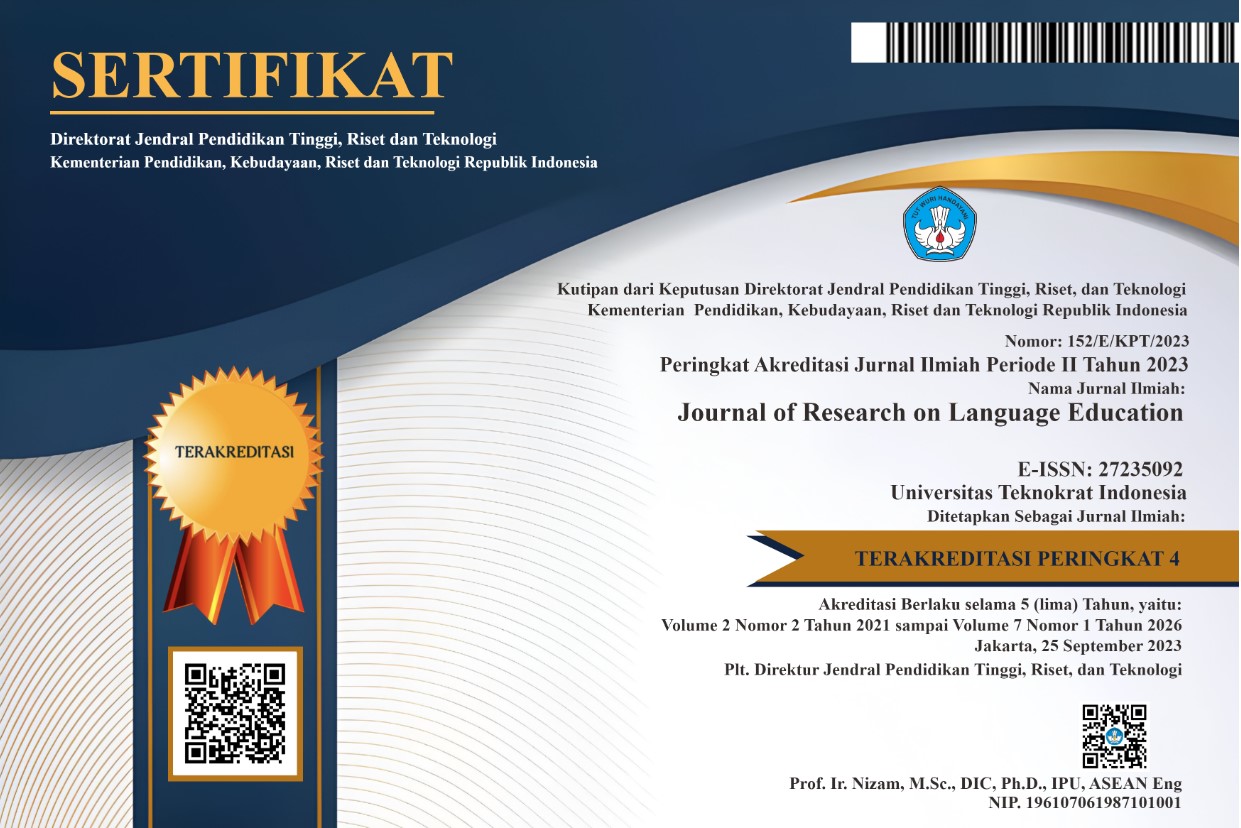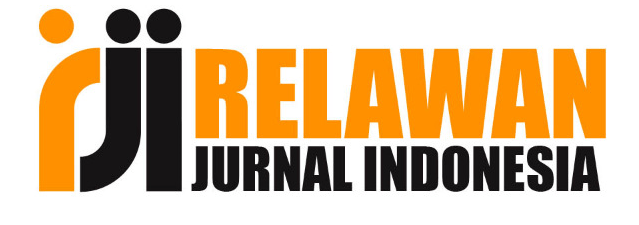IRANIAN UNIVERSITY LEARNERS’ ENGLISH VOCABULARY LEARNING USING SYNONYM AND L1 TRANSLATION
Abstract
Keywords
Full Text:
PDFReferences
Abdul Ridha, N. S. (2014). Associations between EFL Learners’ Beliefs about and their Strategy Use of Translation in English Learning: The Case of Iraqi Learners. Journal of the College of Arts, 70: 31–53.
Aitchison, J. (2003). Words in the mind: An introduction to the mental lexicon (3rd ed.). Oxford: Blackwell.
Alexiou, Thomaï. 2015. “Vocabulary uptake from Peppa Pig: a case study of preschool EFL learners in Greece.” In Current issues in second/foreign language teaching and teacher development: research and practice, edited by Christina Gitsaki, and Thomaï Alexiou, p. 285–301. Cambridge: Cambridge Scholars Publishing.
Boulton, A., & De Cock Sylvie (2017). Dictionaries as aids for language learning. In P. Hanks & G.-M. de Schryver (eds.), International Handbook of Lexis and Lexicography. New York: Springer. DOI: 10.1007/978-3-642-45369-4_25-1
Boustani, Kamel (2019). The Correlation between Translation Equivalence, as a Vocabulary Learning Strategy, and Tunisian EFL Learners’ Speaking Anxiety. Languages, 4(1), 19. https://doi.org/10.3390/languages4010019
Camo, A. C. (2014). The effects of using L1 translation on young learners’ L2 vocabulary learning. Unpublished MA Dissertation Treball De Fi De Grau. Universitat Autonoma de Barcelona.
Celik, M. (2003). Teaching vocabulary through code-mixing. English Language Teaching, 57(4), 361–369. https://doi.org/10.1093/elt/57.4.361
Channell, J. (1981). Applying semantic theory to vocabulary teaching. ELT Journal, 35(2), 115-122.
Cook, G. (2010). Translation in Language Teaching: An Argument for Reassessment. Oxford: Oxford University Press.
Dunbar, S. (1992). Developing vocabulary by integrating language and content. TESL Canada Journal, 9:73-79.
Erten, I. H., & Tekin, M. (2008). Effects of vocabulary acquisition of presenting new words in semantic sets versus semantically unrelated sets. System, 36(3), 407-422.
Folse K. (2004). Vocabulary Myths: Applying Second Language Research to Classroom Teaching. Ann Arbor University of Michigan Press.
Gairns, R., & Redman, S. (1986). Working with Words: A Guide to Teaching and Learning Vocabulary. New York: Cambridge University Press.
Gekoski, W. L. (1980). Language acquisition context and language organization in bilinguals. Journal of Psycholinguistic Research, 9, 429-449.
Harley, B. (1995). Introduction: the lexicon in second language research. In Harley, B. (Ed.), lexical issues in language learning, (pp. 1-28). Philadelphia: John Benjamins.
Havy M and Zesiger P (2017). Learning Spoken Words via the Ears and Eyes: Evidence from 30-Month-Old Children. Front. Psychol. 8:2122. doi: 10.3389/fpsyg.2017.0212
Hanks, J (2018) Supporting language teachers as they engage in research. In: Xerri, D and Pioquinto, C, (eds.) Becoming Research Literate: Supporting Teacher Research in English Language Teaching. ETAS Journal . ETAS , pp. 52-57.
Hashemi, M. R., & Gowdasiaei, F. (2005). An attribute-treatment interaction study: Lexical-set versus semantically-unrelated vocabulary instruction. RELC Journal, 36(3), 341-361.
Higa, M. (1963). Interference effects of intra-list word relationships in verbal learning. Journal of Verbal Learning and Verbal Behavior, 2(2), 170–175.
Higa, M. (1965). The psycholinguistic concept of “difficulty” and the teaching of foreign language vocabulary. Language Learning, 15, 167–179.
Hong, Y (2008). On teaching strategies in second language acquisition. US-China Education Review, 5(1), 61-67.
Hoshino, Y. (2010). The categorical facilitation of L2 vocabulary learning in a classroom setting. RELC Journal, 41(3), 301-312.
Hulstijn, J., & Laufer, B. (2001). Some empirical evidence for the involvement load hypothesis in vocabulary acquisition. Language Learning, 51(3), 539-558.
Hunt, R. R., & Elliot, J.M. (1980). The role of non-semantic information in memory: orthographic distinctiveness effects on retention. Psychol Gen, 109, 49-74.
Jiang, N. (2000). Lexical representation and development in a second language. Applied Linguistics, 21, 1, 47-77.
Joyce, P. (2015). L2 vocabulary learning and testing: the use of L1 translation versus L2 definition. Language Learning Journal, 46(3), 217-227.
Kaufmann, Steve (2020, 23 january). Language learning is mostly about learning words [Video]. YouTube. https://www.youtube.com/watch
Kroll, J. F., & Stewart, E. (1994). Category interference in translation and picture naming: Evidence for a symmetric connection between bilingual memory representations”, Journal of Memory and Language, 33, pp. 149-174.
Latsanyphone, S., & Bouangeune, S. (2009). Using L1 in teaching vocabu- lary to low proficiency level students: A case study at the National University of Laos. English Language Teaching, 2(3), 186–193.
Laufer, B. (1990). Words you know: How they affect the words you learn. In J. Fisiak (Ed.), Further insights into contrastive linguistics (pp. 573–593). Amsterdam: John Benjamins
Laufer, B., & Hulstijn, J. (2001). Incidental vocabulary learning in a second language: The construct of task induced involvement. Applied Linguistics, 22(1), 1-26.
Laufer B, Girsai N. (2008). Form-focused Instruction in Second Language Vocabulary Acquisition: A Case for Contrastive Analysis and Translation. Applied Linguistics, 39(4), 694-716.
Laufer, B., & L. Hadar. (1997). Assessing the effectiveness of monolingual, bilingual, and "bilingualized" dictionaries in the comprehension and production of new words. Modern Language Journal, 81, 189-196.
Liu, J. (2008) L1 use in L2 vocabulary learning: facilitator or barrier? International Education Studies, 1(2), 65-69.
McDaniel, M. A., Pressley, M., & Dunay, P. K . (1987). Long-term Retention of Vocabulary after Key Word and Context Learning. Journal of Educational Psychology, 79(1), 87-89.
Meara, P. (1980). Vocabulary acquisition: A neglected aspect of language learning. Language Teaching and Linguistics Abstracts, 13(4), 221-246.
Milton, J., & Masrai, A. (2015). An investigation of the relationship between L1 lexical translation equivalence and L2 vocabulary acquisition. International Journal of English Linguistics, 5: 1–7.
Nation, I. S. P. (2001). Learning vocabulary in another language. Cambridge: Cambridge University Press.
Nation, I. S. P. (2001). Learning vocabulary in another language. Cambridge: Cambridge University Press.
Nation, I. S. P. (2011). Research into Practice: Vocabulary. Language Teaching, 44(4), 529-539.
Neuner, G. (1992). “The role of experience in a content / and comprehension / oriented approach to learning a foreign language”. In P.J.L. Arnaud and H. Béjoint, Vocabulary and applied linguistics. London: Macmillan.
Oxford University Press, University of Cambridge, & Association of Language Testers in Europe. (2004). Quick placement test: Paper.
Papathanasiou, E. (2009). An investigation of two ways of presenting vocabulary. ELT Journal, 63(4), 313-322.
Pyc, M. A. & Rawson, K. (2007). (2007). Examining the Efficiency of Schedules of Distributed Retrieval Practice. Memory and Cognition, 35(8), 1917-1927.
Ramachandran, S. D., & Rahim, H. A. (2004). Meaning recall and retention: The impact of the translation method on elementary level learners' vocabulary learning. RELC Journal, 35(2), 161–178. https://doi.org/10. 1177/003368820403500205
Rezvani Kalajahi, S. A. R. ( 2012).Vocabulary Learning Strategies and Vocabulary Size of ELT Students at EMU in Northern Cyprus. English Language Teaching, 5(4), 138-149.
Segura, Barón, , and Roquet (2022). Productive vocabulary learning in pre-primary education through soft CLIL. Open Linguistics, 8: 297–327. https://doi.org/10.1515/opli-2022-0194
Shaban, Muhammad. (2013). “Natural order of vocabulary acquisition.” European Academic Research 1(5), 721–33.
Schmitt, N., & Schmitt, D. (2009). Vocabulary notebooks: Theoretical underpinnings and practical suggestions. In P. Hedge, N. Andon, & M. Dewey (Eds.), English language teaching: Major themes in education (Vol.4, pp. 385-397). London: Routledge.
Schneider, V. I., Healy, A. F., & Bourne, L. E. (1998). Contextual interference effects in foreign language vocabulary acquisition and retention. In A. F. Healy & L. E. Bourne (Eds.), Foreign language learning: Psycholinguistic studies on training and retention (pp. 77-90). Mahwah, NJ: Lawrence Erlbaum.
Schryver (eds), International Handbook of Lexis and Lexicography. New York: Springer, n.p. DOI: 10.1007/978-3-642-45369-4_25-1.
Sotoudehnama, E. & Soliemanifard, F. (2013). The Effect of teaching vocabulary through synonymous, semantically unrelated, and hyponym sets on EFL learners'. Issues in Language Teaching, 2(2), 27-56.
Tajik, F. (2018). The Impact of Teaching English Synonym and Antonym Pairs Adjacently and Non-Adjacently on Iranian E FL Learners' Vocabulary Learning and Retention. Modern Journal of Language Teaching Methods, 8(3), 200-225.
Thorburry, S. (2002). How to teach vocabulary. England: Pearson Education Limited. Ur, P., (1998). A course in language teaching. Cambridge University Press.
Tinkham, T. (1993). The effect of semantic clustering on the learning of second language vocabulary. System, 21, 371–380.
Tinkham, T. (1997). The effect of semantic and thematic clustering of the learning of second language vocabulary. Second Language Research, 13(2), pp. 138-163.
Udaya, M. (2019). Use of L1 in Enhancing L2 Vocabulary. European Journal of English Language Teaching, 4(4), 202-215.
Waring, R. (1997). The negative effects of learning words in semantic sets: A replication. System, 25, 261–274.
Webb, S. A. & Chang, A, C-S. (2015). Second language vocabulary learning through extensive reading: How does frequency and distribution of occurrence affect learning? Language Teaching Research, 19(6), 667-686.
Wong Kwok Shing, Richard. 2006. “Enhancing English among second language learners: The pre-school years.” Early Years 26(3), 279–93. doi: 10.1080/09575140600898456.
Zheng, H., K, B., & Kim, H. (2009). Exploiting noun phrases and semantic relationships for text document clustering. Information Sciences, 179(13), 2249-2262.
DOI: https://doi.org/10.33365/jorle.v4i2.2840
Refbacks
- There are currently no refbacks.

This work is licensed under a Creative Commons Attribution-NonCommercial-ShareAlike 4.0 International License.

Articles published in Journal of Research on Language Education is licensed
under a Creative Commons Attribution-ShareAlike 4.0 International License.
English Education Study Program, Faculty of Arts and Education.
Universitas Teknokrat Indonesia
Zainal Abidin Pagaralam 9-11 Bandar Lampung, Indonesia
All rights reserved.








